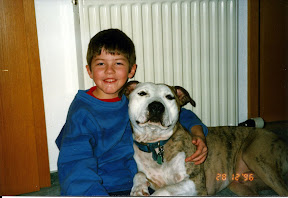Farewell
We said goodbye to Wilbur last Tuesday a little after midnight. He passed away at home on his own bed, next to ours. He was looking into our eyes as he’s done for 15 years, then he was gone. We stroked him and talked to him for long minutes afterwards. So many tears.
Wilbur lived well, took offense at nothing, and made friends everywhere he lived, in New York and Germany and Wisconsin. People we'd never met, especially children, greeted him by name. We were anonymous; he was not. Once at an outdoor market in Germany, total strangers came up and said, “Ist das nicht der Wilbur?” (“Isn’t that Wilbur?”)
He practiced the Golden Rule with all living beings, whether squirrel or bird or cat or dog. Yet any number of people were terrified by him. He was, after all, an American Staffordshire Terrier, a breed regarded by some as a Pit Bull. As with people though it’s the individual that counts. He never groveled for affection; petting wasn’t a priority, but firm contact was. He slept confidently on or under many visitors and family. You name it, the permutation has occurred: head on chest, ribs on foot, limb on limb.
He hated cold -- whimpering for a blanket to be thrown over him at night -- and loved the sun. On hot days he would lie on the sidewalk, belly and paws up, balanced stock still, sound asleep. Passersby and drivers often stopped because they thought him dead or injured. One day an alarmed man came to the door, said that he was a vet, and told Ruth her dog was dying. They went out and stood together over Wilbur. Ruth reassured him everything was normal, but the vet insisted that there were no signs of life. When Ruth gently called his name, Wilbur stirred and opened his eyes. Surprised and chagrined, the vet apologized and went on his way.
Last Monday we feared Wilbur’s time was near. His appetite was off, his weight was down, and minor exertions exhausted him. He rarely went to his water or food bowls; when he walked it was aimless. Old age and infirmity finally caught up with him. His file at the vet (a veterinary teaching hospital) is well into its second "phonebook." The pathologists are doing an extensive post-mortem; the final histological studies will take months. Possibly we'll better understand some of the changes of his last years and months. Above all, the clinicians and specialists will learn from comparing his tissue with those phonebooks. In death, as in life, Wilbur’s influence will be positive.
The day after he passed away, a two-year-old boy who had met Wilbur once many months ago climbed the stairs to the front porch calling for him. His six-year-old sister overheard us telling their mother what happened, so she gently broke the news to her little brother. He turned away from the front door and solemnly announced, "Wilbur all gone, Wilbur all gone."
He was a good dog.
3/18/1995 - 6/23/2010
|
|
|
|
|
|
|
|

|
|
|
|
|
